American Girls in Italy
|
The "American Girls" in Italy.
Interpretations, perceptions and misrepresentations
|
The iconic image was taken decades ago (august 12-1951) by photographer Ruth Orkin
You know the photo. You’ve seen it a hundred times.
A beautiful, statuesque young woman is walking down a street in Florence, Italy.
She’s clutching her shawl, and she seems to be moving swiftly.
More than a dozen men are staring at her longingly.
For many years the photography was considered obscene because of this bent-over whistling man.
He holds an umbrella in one hand and his crotch in the other. Craig says that, for years, when the picture was published the man’s hand was airbrushed out.
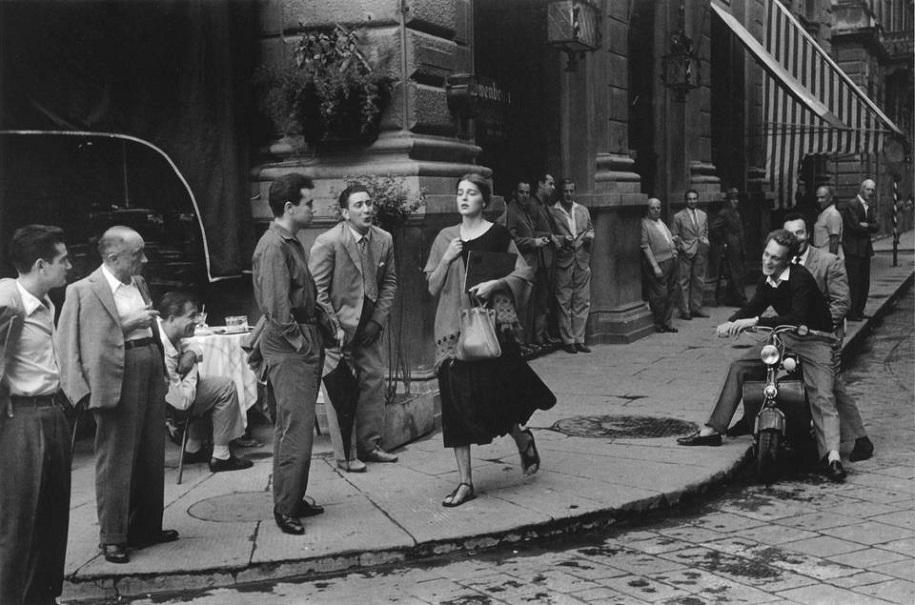
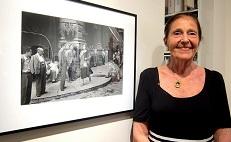 In 2011 the picture marked its 60th anniversary and in that occasion Ninalee Craig, now 83 wanted to explain what the photo represents, and what it doesn't. Some people want to use it as a symbol of harassment of women, but that’s what we’ve been fighting all these years,” Craig said in a telephone interview from her home in Toronto. In 2011 the picture marked its 60th anniversary and in that occasion Ninalee Craig, now 83 wanted to explain what the photo represents, and what it doesn't. Some people want to use it as a symbol of harassment of women, but that’s what we’ve been fighting all these years,” Craig said in a telephone interview from her home in Toronto.
“It’s not a symbol of harassment. It’s a symbol of a woman having an absolutely wonderful time!”
Men who see the picture always ask me: Was I frightened?
Did I need to be protected? Was I upset?”
Craig said. “They always have a manly concern for me.
Women, on the other hand, look at that picture, and the ones who have become my friends will laugh and say, ‘Isn’t it wonderful?
Aren’t the Italians wonderful? ...
They make you feel appreciated”Craig says the expression on her face is “one of being above it all.
You would never walk—even today—through a bunch on men on a road, making eye contact.
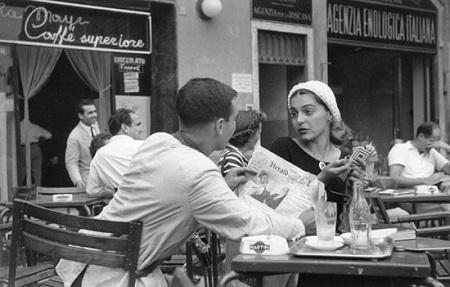
I was walking with confidence in Florence, a city I knew and loved.”
She turned plenty of heads wherever she went because she was 6 feet tall and traveling alone.
She knows the men in the photo appear to be leering and lascivious, but she insists they were harmless.
“Very few of those men had jobs,” Craig said. “Italy was recovering from the war and had really been devastated by it … I can tell you that it wasn’t the intent of any man there to harass me.”
Orkin and Craig met in Florence at the American Express office, a spot where ex-pats could collect mail while abroad. Both women were 23.
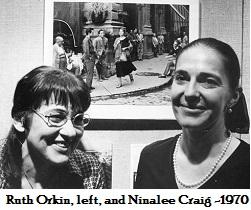 “The big debate about the picture, which everyone always wants to know, is: Was it staged? NO!” Craig said. “No, no, no! “The big debate about the picture, which everyone always wants to know, is: Was it staged? NO!” Craig said. “No, no, no!
You don’t have 15 men in a picture and take just two shots.
The men were just there ... The only thing that happened was that Ruth Orkin was wise enough to ask me to turn around and go back and repeat [the walk].”
After she felt ready to end her European tour in 1951 — and after spending less than $1,000 on her entire trip — Craig returned home to New York.
She taught school for a time, then got a job writing advertising copy, then married an Italian widower and moved to Milan.
That marriage ultimately ended in divorce, so she returned to New York, worked in advertising again, met a Canadian man on a blind date and married him.
Sources : Laura T Coffey - Culture & arts
The Irish Pretender - By Miriam Cooke.

Miriam Cooke is a writer, archaeologist, a broadcaster for BBC, C4, five, Discovery and National Geographic and an actress.
She is a presenter on the BBC One show Country Track's.
Miriam's debut novel Drusila Blood is out now; a gripping occult thriller where the past and present weave together in a tale of passion, intrigue, murder and the supernatural.
Have a good look at two photos. The original may be very familiar to you, and the other here below may seem, well, it may seem a little distracting.
You're probably asking yourself why the poor girl isn’t wearing a bra with that slightly revealing dress.
I know I am, and I am the poor girl in the photo. So… the reconstruction photo.
We love them — don’t we? And yet, they never really work.
It may be the same café in Florence, forty years later; it may have a similar bunch of leering Italians albeit from a slightly different angle.
But here, the main difference, I believe, is the message of the above photo.
A perhaps, misreading of the original photo, or just a silly styling mistake.
Whereas the original photo ‘An American girl in Italy’ is a wonderful visual depiction of the sometimes intimidating and misogynist Italian street attitude, the reconstruction apparently misses the point.
Even while this photo was being shot, I was aware of the incongruity of the styling.
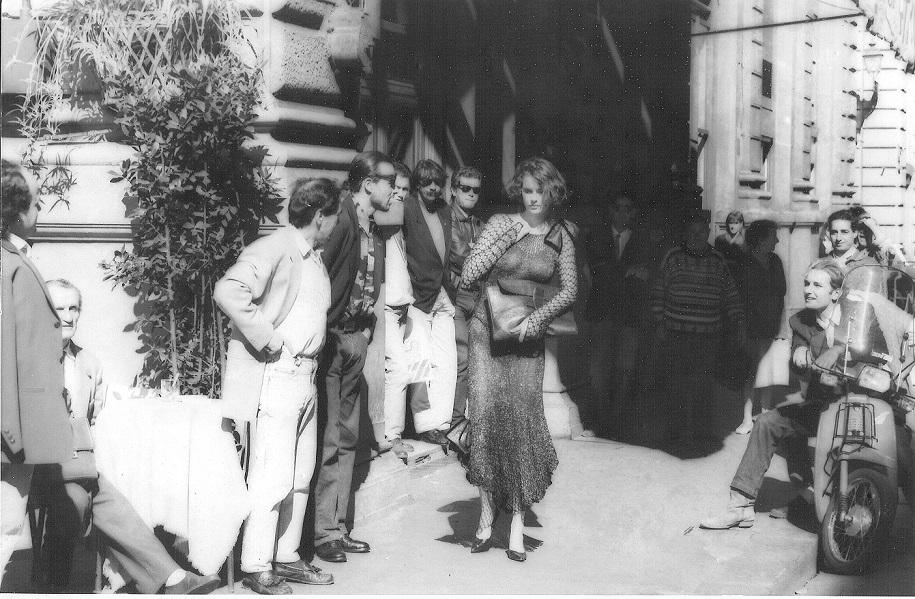
The focus of the original is the sedate American woman cringing against the barrage of aggressive attention.
In the recreation I was part of, the men were witnessing a rather skinny yet oddly buxom gal shuffling down the street in pointy shoes and revealing crocheted dress.
Now I’ve nothing against revealing crocheted dresses, I vaguely remember it was a rather lovely revealing crocheted dress, by a rather lovely local lady designer who knew the photographer, but it hardly recreated the image of a normal everyday girl about town, hassled for no reason by the swarthy locals.
I look like I’m doing the walk of shame after a stopover.
Jesus, I’d stare at me, if only to marvel at strange finger attachments and bows on the shoulders.
I think my photo ends up a more disturbing image, the men are a little more menacing, and where with the original we wonder at the inappropriate ogling, in the recreation we still censure the men and feel for the girl but we question her dress sense and choice.
In this photo it almost implies the adage that women dressing a certain way deserve a certain reaction.
So what was the point then? Actually merely a modern day attempt to capture the feel of a famous old photo.
Although the original by Ruth Orkin was slightly staged (the subject Nina Lee Craig, was asked to repeat the walk a second time), it was in effect two independent women wandering around Florence on a single day, snapping pictures and recording for posterity what was common and frankly often intimidating behavior enacted by men of a(dare I say it) certain type in Italy.
Forty years later I was that young woman living in Florence, lolloping around town with my best girlfriend. I ran the very same gamut of emotions the girl in the fifties did, and strangely very little had changed.
I was once even shouted at by a five year old boy cheered on by his male relatives ( che bella figa – ‘what a lovely pu**y’).
But here the dress was the down fall. Which is a shame. I cannot paint all the men of Italy with the same generic brush, because that would be mad mad mad.
Italian men can be a breath of gentleman like air.
I should know - I went out with a few in my time.
This picture merely encapsulates a peculiar Italian behavior, which still existed forty years on.
Things may have changed over the last decade or so since I lived there. I hope so.
But that is for some other woman in her twenties to say. (disclaimer - Apologies to the photographer of my photo whose name I have forgotten. I salute your endeavor).
Still a beautiful picture which holds special memories for me. A wonderful time as a young girl roaming the labyrinthine streets of Florence. Ogled or not.
The "Italian girl in Milano" -
Gli Italiani si voltono (The Italians turn around )
1954 - by Mario Blasi - Taken in Corso Emanuele (Milano)
In 1994 the photo was exhibited at the Guggenheim Museum in New York.
A point of view about the image below is expressed by Karen Fayeth, a blogger and writer...read on.
 I am utterly fascinated by this photograph.
I first started looking at it closer, because my best friend and I are talking about a girl’s trip to Italy next year.
We’ve all heard the stories, right?
Is this what Italy is all about?
I have no idea the story behind this photograph, but along with being totally can’t-take-my-eyes-off it intrigued, it also scares the hell out of me.
It’s so…visceral.
The look on the faces of all the men… You are pretty sure you know what they are thinking.
And she, dressed in white, little Red Riding Hood plunges, fearlessly, into the pit of wolves.
The guy to her left, with his bottom lip tucked into his teeth TOTALLY thinks he’s got a chance.
I mean, that dude is pretty sure he’s going to score.
Which makes me hate him.
The guy to her right on the scooter looks skeptical. Perplexed.
Dare I say, scholarly? For that reason, he’s the one I’m into. I’d choose him. I am utterly fascinated by this photograph.
I first started looking at it closer, because my best friend and I are talking about a girl’s trip to Italy next year.
We’ve all heard the stories, right?
Is this what Italy is all about?
I have no idea the story behind this photograph, but along with being totally can’t-take-my-eyes-off it intrigued, it also scares the hell out of me.
It’s so…visceral.
The look on the faces of all the men… You are pretty sure you know what they are thinking.
And she, dressed in white, little Red Riding Hood plunges, fearlessly, into the pit of wolves.
The guy to her left, with his bottom lip tucked into his teeth TOTALLY thinks he’s got a chance.
I mean, that dude is pretty sure he’s going to score.
Which makes me hate him.
The guy to her right on the scooter looks skeptical. Perplexed.
Dare I say, scholarly? For that reason, he’s the one I’m into. I’d choose him.
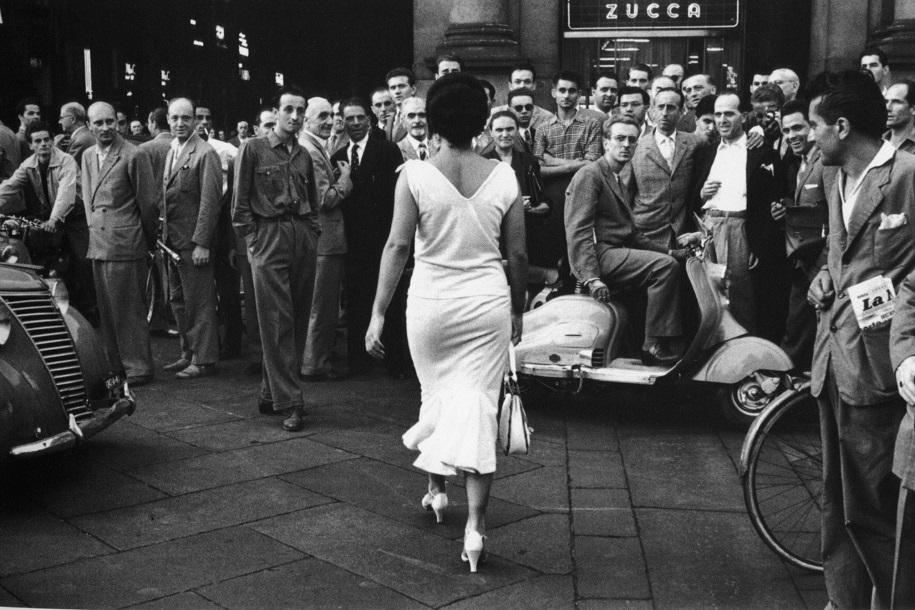
I have no idea who the woman is or what she looks like from the front, but my god, that kind of male attention is both craved and rejected by women.
How can she be so confident walking into that?
Does she possess the certainty of a truly beautiful woman?
Is she actually terrified but hides it well?
Is she an Italian woman and thus used to ignoring this kind of stuff?
It conflicts me. I’m not a feminist. It doesn’t make me angry like “she deserves more respect!”
But I’m also not an old fashioned gal either of the “boys will be boys” fey sort of excuse making.
I can’t quite cipher out what it is that gets to me about this photograph. But oh, it gets to me.
Lets try to answer some questions for Karen so that she can finally have some rest at night without having to wonder whatever happened to that 'innocent "Red Riding Hood".
First of all, the photo shoot was staged.
Visible are the symbols of the Italian economic miracle, peeking on the left is the grill of a car, on the right is the lambretta (scooter), and top center/ right we note the sign of Zucca, a high class restaurant.
Who is " this curvaceous woman in white" anyway?
...Well...she was the only woman in Italy at the time who could be recognized by looking at her from behind only.
She might like to wear white, but an innocent Little Riding Hood she was not.
Her name is Moira Orfei and at the time when the picture was taken she was 16.
Her trademark Gipsy look and sexy eyes were enough to send any man in tilt...and I wouldn't be surprised if most of those guys, if not all, at that precise moment were all spaced out and unable to formulate any thoughts.
Being so close to a famous personality in those days was not a ordinary event.
She has still today a spicy and genuine personality, known also not to mince words.
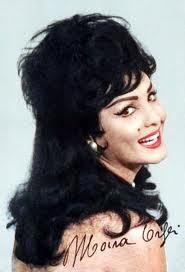 A bit about Moira : Moira Orfei, (aka Miranda Orfei), is a popular Italian actress and television personality, an institution of the Italian cinema, still regarded as the queen of the Italian circus.
Raised in a family who owned the circus company Circus Orfei, Moira became the symbol of circus in Italy and attained international fame.
The Circus Moira A bit about Moira : Moira Orfei, (aka Miranda Orfei), is a popular Italian actress and television personality, an institution of the Italian cinema, still regarded as the queen of the Italian circus.
Raised in a family who owned the circus company Circus Orfei, Moira became the symbol of circus in Italy and attained international fame.
The Circus Moira Orfei itself was founded in 1960.
Moira has been photographed in various scenes as a rider, trapeze artist, acrobat, elephants and doves trainer.
Moira's excessively garish image mirrors her eccentric and exuberant personality.
It was Dino De Laurentiis who suggested that she change her name from Miranda to Moira.
From then on, Moira's face became an effigy of unchanging characteristics: heavy make-up with eyes coated with eyeliner, bright lipstick, an accentuated mole above the lip, hair tied in a turban.
Promotional billboards were carpeted with this picture in every city that the circus stopped.
As a result, Moira has become one of the most recognized faces in Italy (which might explain the perplexed and curios look on the face of those men in the picture.)
Almost by chance, Moira also became a film actress, acting in over forty films, from comedies to Sword and sandal films (among which many Italian crime films).
It has been said that if Moira had studied drama she could have been good as Sophia Loren.
Moira retired from performing in the late 1990s, but she did not cease from supervising every detail of her organization.
Neither did she entirely disappear from the ring: she still greets her audience at the opening of each performance, and her entrance always prompts standing ovations and flower-throwing.
In recent years, Moira has appeared in a few screen comedies and has become a much sought-after guest on TV talk shows.
With its large menagerie and classy productions, its fine orchestra and true corps-de-ballet—together with Moira's attention to detail and her booking some of the world's finest acts—Moira Orfei's circus is among the most respected in Europe.
|
Following the second world war, Italy was still struggling to find its way, meanwhile, the cliche' acquired by the Italian male was that of a 'Latin lover' or, 'horny sidewalk whistler'.
Gli Italiani si voltono (The Italians turn around ) - is part of 6 short documentaries filmed in the early 50's in Rome.
Is the Italy of the after war. A time when the Italians 'turn around' not only to admire a beautiful women, but also to admire all that is beautiful, venturing into a wonderful and exciting recovery, both economic and cultural, while writing memorable pages in the cinema, literature, painting, design and photography.
|
Moira Orfei website
Poster >>> |
|
|

|
